Is GIMP too slow or unresponsive on your Windows PC? This post will help you enhance GIMP’s performance and make it run faster and smoother on Windows 11/10.
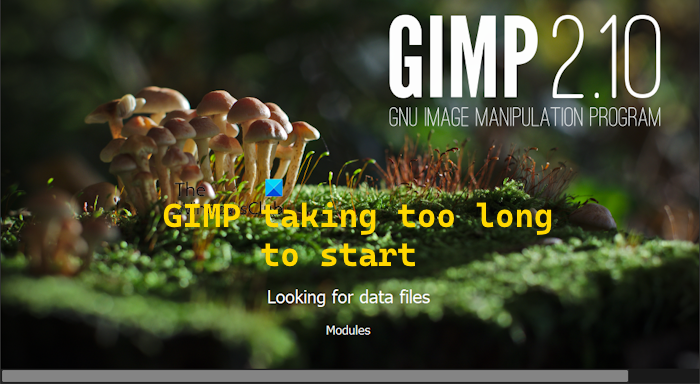
Why does GIMP take so long to open on my PC?
Several GIMP users have complained that GIMP takes forever to load. This issue is likely to occur when your system doesn’t meet the hardware requirements to run the app. Also, if there are too many plugins and fonts being used in GIMP, it is likely to slow down the startup time of the app. Besides that, an outdated app version or corrupted app installation can also cause the same issue.
Fix GIMP unresponsive or very slow to start
If GIMP is too slow to start or becomes unresponsive randomly, use the following solutions to speed up GIMP performance and fix these issues:
- Preliminary checklist.
- Update GIMP.
- Disable unnecessary plugins.
- Reduce fonts.
- Set a high tile cache size in GIMP.
- Uninstall GIMP completely and reinstall it.
1] Preliminary checklist
- As we mentioned earlier, GIMP requires a particular amount of RAM and CPU resources to work without any issues. Hence, check your computer’s specifications and, if required, upgrade your hardware.
- The issue can also occur if there are too many background apps running on your PC. Hence, open Task Manager using CTRL+SHIFT+ESC and kill all unnecessary programs using the End task button.
- If your PC has a virus or malware infection, you are likely to experience performance issues with apps like GIMP. So, run a virus scan and remove detected threats from your computer.
- Make sure your device drivers especially graphics drivers are up-to-date.
2] Update GIMP
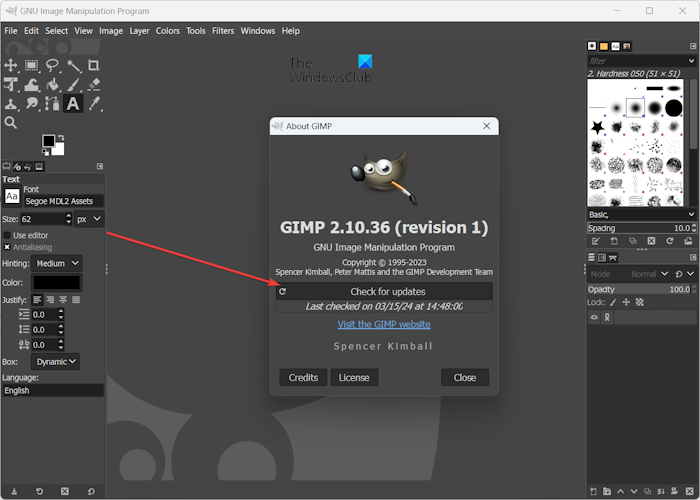
Using the most recent software and applications is advisable to prevent any potential performance issues. If your GIMP is out-of-date, update it right away.
- First, open GIMP and go to the Help menu.
- Now, select the About GIMP option.
- In the opened dialog, press the Check for updates button and let GIMP check for available updates.
- If updates are available, click on the Download button and follow the onscreen instructions to complete the process.
Once GIMP is updated, you can reopen it and see if the issue is resolved.
3] Disable unnecessary plugins
If you are having too many plugins enabled in GIMP, it will take some time to load. Disabling some plugins that you don’t use regularly is recommended.
To do that, open the GIMP app and click on the Edit > Preferences option.
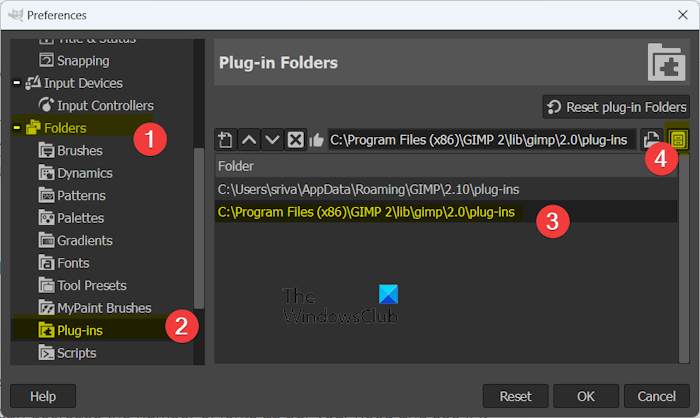
Expand the Folders option and click on the Plug-ins folder. It will display the location where your plugins are stored. You can select the location and click on the Show file location in the file manager button to open the directory in File Explorer.
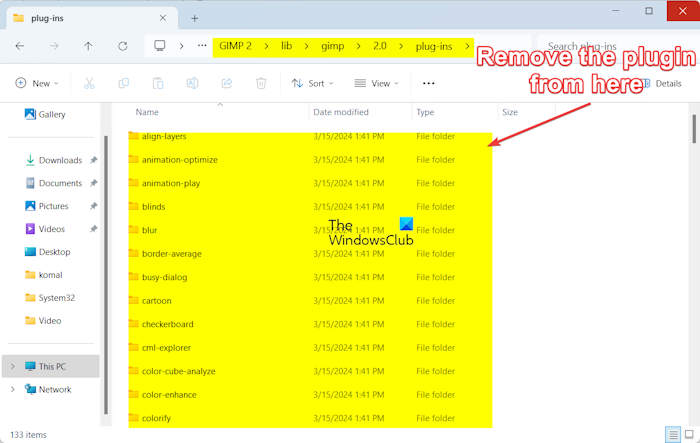
Next, open the plug-ins folder and identify the plugin/s you don’t want to use and select the plugin/s folder that is not required, press the CTRL+X hotkey, go to your desktop, and paste the folder using CTRL+V. You can keep this folder in any other location as you wish. Doing so will enable you to restore the plugin/s if you need it in the future; you can put it back in the plug-ins folder of GIMP.
Once done, restart GIMP and see if the problem is resolved.
Read: How to remove the Background from a Photo using GIMP?
4] Reduce fonts
Another potential cause of slow startup of GIMP is the number of fonts you are using. You can decrease the number of fonts as per your need and see if it helps in speeding up GIMP loading time.
Click on the Edit menu in GIMP and go to the Preferences > Folders > Fonts option and find out the GIMP fonts’ location on your system.
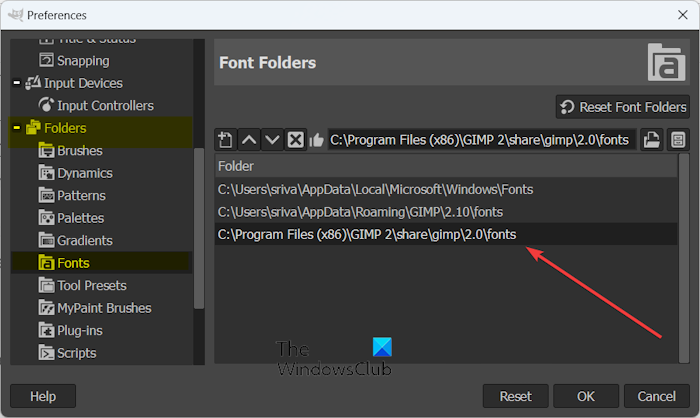
You can then open the fonts folder in File Explorer.
If you have customized fonts installed on your PC that you don’t wish to use anymore, delete them. You can also move the font from the above location to another location on your PC to restore it if necessary.
Read: How to create Pixel Art in GIMP?
5] Set a high tile cache size in GIMP
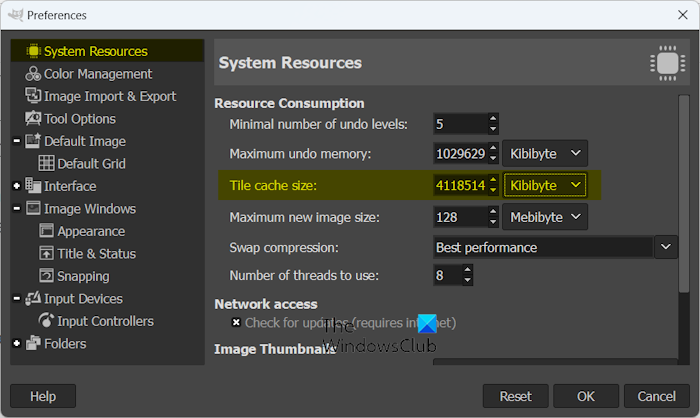
Furthermore, you can speed up GIMP by customizing its System Resources settings. You can allocate more memory to GIMP to make it run faster. Here are the steps to do that:
- First, go to Edit > Preferences in GIMP and select the System Resources option.
- Now, look for the Tile cache size option and increase its value (as per available RAM).
- Once done, press the OK button and see if the issue is fixed.
Read: How to Curve Text in GIMP on Windows PC?
6] Uninstall GIMP completely and reinstall it
If GIMP is still not working correctly or keeps freezing, consider reinstalling the app.
To uninstall GIMP, close the app and open the Settings app using Win+I. Go to the Apps > Installed apps section and find the GIMP app. Then, press the three-dot menu button present next to it, choose the Uninstall option, and follow the instructions to remove it.
Once done, delete the GIMP-related folders from its installation folder, AppData, and other locations from your PC.
After that, restart your PC and download the latest version of GIMP. Finally, install the app and see if it works fine or not.
Read: GIMP paintbrush not working; won’t let you draw.
I hope this helps!
Why does it take so long to export from GIMP?
If GIMP is taking a long to export your images, it might be the case that the target directory contains a large number of files. So, in that case, you can clean up the target folder or set up a new folder to save graphics projects created with GIMP.
Why is GIMP so slow on Mac?
There can be different reasons why GIMP is slow on Mac. It could be due to lower hardware specifications or software compatibility issues. If your Mac is not up-to-date, you might face this issue. Apart from that, many plugins can also cause the same problem.
Leave a Reply